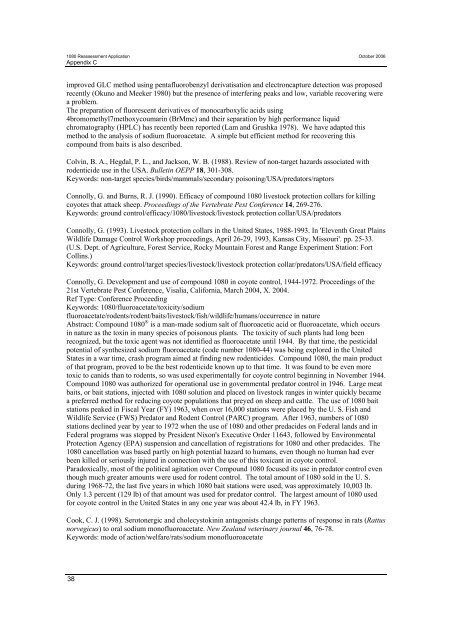Source: Landcare Research (1964). Control of poisons. Royal ...
Source: Landcare Research (1964). Control of poisons. Royal ...
Source: Landcare Research (1964). Control of poisons. Royal ...
You also want an ePaper? Increase the reach of your titles
YUMPU automatically turns print PDFs into web optimized ePapers that Google loves.
1080 Reassessment Application October 2006<br />
Appendix C<br />
improved GLC method using pentafluorobenzyl derivatisation and electroncapture detection was proposed<br />
recently (Okuno and Meeker 1980) but the presence <strong>of</strong> interfering peaks and low, variable recovering were<br />
a problem.<br />
The preparation <strong>of</strong> fluorescent derivatives <strong>of</strong> monocarboxylic acids using<br />
4bromomethyl7methoxycoumarin (BrMmc) and their separation by high performance liquid<br />
chromatography (HPLC) has recently been reported (Lam and Grushka 1978). We have adapted this<br />
method to the analysis <strong>of</strong> sodium fluoroacetate. A simple but efficient method for recovering this<br />
compound from baits is also described.<br />
Colvin, B. A., Hegdal, P. L., and Jackson, W. B. (1988). Review <strong>of</strong> non-target hazards associated with<br />
rodenticide use in the USA. Bulletin OEPP 18, 301-308.<br />
Keywords: non-target species/birds/mammals/secondary poisoning/USA/predators/raptors<br />
Connolly, G. and Burns, R. J. (1990). Efficacy <strong>of</strong> compound 1080 livestock protection collars for killing<br />
coyotes that attack sheep. Proceedings <strong>of</strong> the Vertebrate Pest Conference 14, 269-276.<br />
Keywords: ground control/efficacy/1080/livestock/livestock protection collar/USA/predators<br />
Connolly, G. (1993). Livestock protection collars in the United States, 1988-1993. In 'Eleventh Great Plains<br />
Wildlife Damage <strong>Control</strong> Workshop proceedings, April 26-29, 1993, Kansas City, Missouri'. pp. 25-33.<br />
(U.S. Dept. <strong>of</strong> Agriculture, Forest Service, Rocky Mountain Forest and Range Experiment Station: Fort<br />
Collins.)<br />
Keywords: ground control/target species/livestock/livestock protection collar/predators/USA/field efficacy<br />
Connolly, G. Development and use <strong>of</strong> compound 1080 in coyote control, 1944-1972. Proceedings <strong>of</strong> the<br />
21st Vertebrate Pest Conference, Visalia, California, March 2004, X. 2004.<br />
Ref Type: Conference Proceeding<br />
Keywords: 1080/fluoroacetate/toxicity/sodium<br />
fluoroacetate/rodents/rodent/baits/livestock/fish/wildlife/humans/occurrence in nature<br />
Abstract: Compound 1080 ® is a man-made sodium salt <strong>of</strong> fluoroacetic acid or fluoroacetate, which occurs<br />
in nature as the toxin in many species <strong>of</strong> poisonous plants. The toxicity <strong>of</strong> such plants had long been<br />
recognized, but the toxic agent was not identified as fluoroacetate until 1944. By that time, the pesticidal<br />
potential <strong>of</strong> synthesized sodium fluoroacetate (code number 1080-44) was being explored in the United<br />
States in a war time, crash program aimed at finding new rodenticides. Compound 1080, the main product<br />
<strong>of</strong> that program, proved to be the best rodenticide known up to that time. It was found to be even more<br />
toxic to canids than to rodents, so was used experimentally for coyote control beginning in November 1944.<br />
Compound 1080 was authorized for operational use in governmental predator control in 1946. Large meat<br />
baits, or bait stations, injected with 1080 solution and placed on livestock ranges in winter quickly became<br />
a preferred method for reducing coyote populations that preyed on sheep and cattle. The use <strong>of</strong> 1080 bait<br />
stations peaked in Fiscal Year (FY) 1963, when over 16,000 stations were placed by the U. S. Fish and<br />
Wildlife Service (FWS) Predator and Rodent <strong>Control</strong> (PARC) program. After 1963, numbers <strong>of</strong> 1080<br />
stations declined year by year to 1972 when the use <strong>of</strong> 1080 and other predacides on Federal lands and in<br />
Federal programs was stopped by President Nixon's Executive Order 11643, followed by Environmental<br />
Protection Agency (EPA) suspension and cancellation <strong>of</strong> registrations for 1080 and other predacides. The<br />
1080 cancellation was based partly on high potential hazard to humans, even though no human had ever<br />
been killed or seriously injured in connection with the use <strong>of</strong> this toxicant in coyote control.<br />
Paradoxically, most <strong>of</strong> the political agitation over Compound 1080 focused its use in predator control even<br />
though much greater amounts were used for rodent control. The total amount <strong>of</strong> 1080 sold in the U. S.<br />
during 1968-72, the last five years in which 1080 bait stations were used, was approximately 10,003 lb.<br />
Only 1.3 percent (129 lb) <strong>of</strong> that amount was used for predator control. The largest amount <strong>of</strong> 1080 used<br />
for coyote control in the United States in any one year was about 42.4 lb, in FY 1963.<br />
Cook, C. J. (1998). Serotonergic and cholecystokinin antagonists change patterns <strong>of</strong> response in rats (Rattus<br />
norvegicus) to oral sodium mon<strong>of</strong>luoroacetate. New Zealand veterinary journal 46, 76-78.<br />
Keywords: mode <strong>of</strong> action/welfare/rats/sodium mon<strong>of</strong>luoroacetate<br />
38








![Application for test certificate [pdf, 131kb]](https://img.yumpu.com/50666502/1/184x260/application-for-test-certificate-pdf-131kb.jpg?quality=85)








